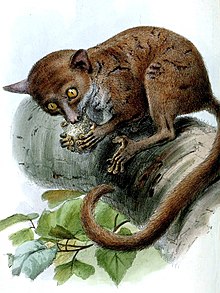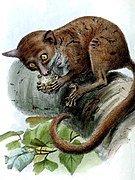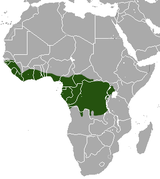
Lorisidae is a family of strepsirrhine primates. The lorisids are all slim arboreal animals and comprise the lorises, pottos, and angwantibos. Lorisids live in tropical, central Africa as well as in south and southeast Asia.

Galagos, also known as bush babies or nagapies, are small nocturnal primates native to continental, sub-Sahara Africa, and make up the family Galagidae. They are considered a sister group of the Lorisidae.

Lesser bushbabies, or lesser galagos, are strepsirrhine primates of the genus Galago. They are classified, along with the other bushbaby and galago genera in the family Galagidae. They are probably the most numerous primate in Africa, and can be found in every large forest on the continent, inhabiting forested areas, savannas, riverine bush and open woodlands.

The greater galagos or thick-tailed bushbabies are three species of strepsirrhine primates. They are classified in the genus Otolemur in the family Galagidae.

The Zanzibar bushbaby, Matundu dwarf galago, Udzungwa bushbaby, or Zanzibar galago is a primate of the family Galagidae. An adult typically weighs 150 grams (5.3 oz), its head-body length is 14 to 15 centimetres and its tail is between 12 and 15 centimetres long. Like other species of galagos, its diet consists mainly of fruit, insects, and tree gums.

Presbytis is a genus of Old World monkeys also known as langurs, leaf monkeys, or surilis. Members of the genus live in the Thai-Malay Peninsula, on Sumatra, Borneo, Java and smaller nearby islands.

Bioko Allen's bushbaby, also known as the Bioko squirrel galago, is a species of primate in the galago family found in Cameroon, Nigeria, and the island of Bioko, Equatorial Guinea. Its natural habitat is subtropical or tropical dry forests. The bushbaby is currently near-threatened, according to the International Union for Conservation of Nature.
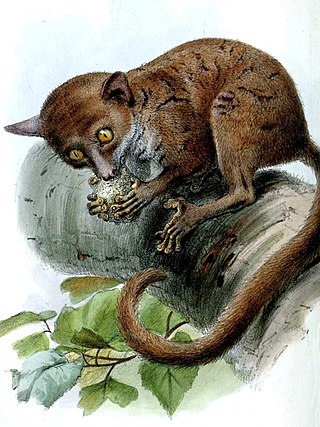
Prince Demidoff's bushbaby, also known as Prince Demidoff's galago, is a species of primate in the family Galagidae. It is native to parts of tropical West and Central Africa.
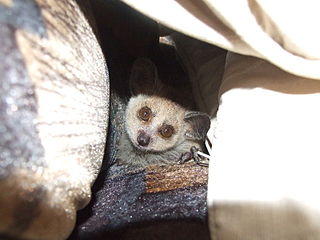
Grant's bushbaby, also known as Grant's lesser bushbaby or the Mozambique lesser bushbaby, is a species of primate in the family Galagidae. It is found in Malawi, Mozambique, Tanzania, and Zimbabwe. Its natural habitat is subtropical or tropical dry forests. It is a common species and the International Union for Conservation of Nature has assessed its conservation status as being of "least concern".

The dusky bushbaby is a species of primate in the family Galagidae. It is also known as Matschie's galago, in honour of the German zoologist Paul Matschie, curator of mammals at the Museum für Naturkunde in Berlin. Native to tropical Central Africa, it is found in forests in Burundi, Rwanda, Democratic Republic of the Congo and Uganda. The species is small with a long tail, and has an arboreal, nocturnal and omnivorous lifestyle.

The Uluguru bushbaby, also known as the mountain dwarf galago or the Amani dwarf galago, is a species of primate in the family Galagidae. Like all galagos, it is a strepsirrhine primate. It is endemic to the Eastern Arc Mountains of Kenya and Tanzania at altitudes of 1,200 - 2,000 m. It has its own set of unique calls, which helps distinguish it from other species of bushbaby.

The Rondo dwarf galago or Rondo bushbaby is a species of primate in the family Galagidae. The dwarf galagos are the smallest members of the genus Galagoides. It weighs less than 100 grams, making it the smallest known galago. It is endemic to Tanzania where its natural habitat is subtropical or tropical dry forests. It lives in an area reported in 2012 to be less than 100 square kilometers and is threatened by habitat loss due to logging. While it was discovered in the 1950s, the Rondo dwarf galago was deemed data deficient until 1996. In 1996, the Rondo dwarf galago was fully described as a species. It is now listed as one of "The World's 25 Most Endangered Primates."

Thomas's bushbaby is a species of primate in the family Galagidae. It is found in Angola, Burundi, Cameroon, Democratic Republic of the Congo, Equatorial Guinea, Gabon, Kenya, Nigeria, Rwanda, Tanzania, Uganda, and Zambia.

The squirrel galagos are a group of four species of strepsirrhine primates. They are classified in the genus Sciurocheirus of the family Galagidae.
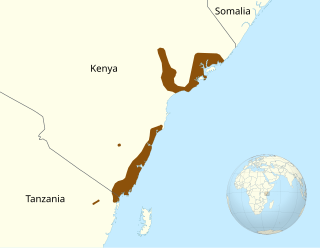
The Kenya coast galago is a species of primate in the family Galagidae. It is found across Kenya and Tanzania, particularly around the northern coastal area of each of the countries, and has been located living from sea level to around 350 metres (1,150 ft) above sea level.

The Angolan dwarf galago is a species of dwarf galago native to Angola, and was named after western Angolan Kumbira Forest. Though 36 individuals of the Angolan dwarf galago were identified in September 2013, it was declared as a new species in 2017, and is now the nineteenth species of galago to be identified. Its call, described as "A loud chirping crescendo of longer notes, followed by a fading twitter", was enough to separate it as a new species, without any genetic identification, due to its uniqueness.

The Primatology and Conservation programmes at Oxford Brookes University are part of the Department of Social Science, with links to the Department of Health and Life Sciences. It traces its origins to the anthropology courses offered at the then Oxford Polytechnic in the 1970s and developed into a globally recognised centre for primate conservation.

The eastern dwarf galagos are a group of five species of strepsirrhine primates of the family Galagidae, native to East Africa. They were formerly classified in the genus Galagoides but have been moved to their own genus, Paragalago, based on genetic evidence, and supported by differences in vocalizations and morphology. The three western/Congolian species remain in Galagoides.
